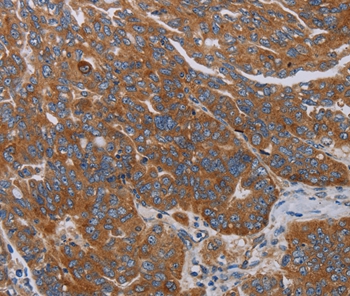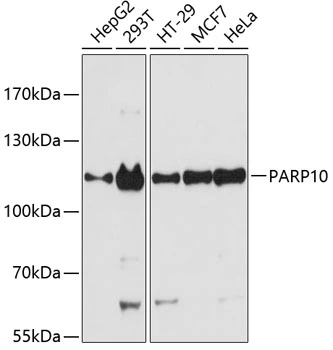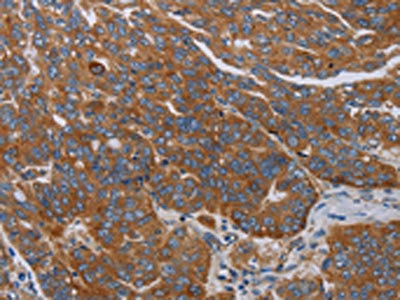![Immunofluorescence using anti-PARP-10 [ARTD10] (human), mAb (5H11). Method: T47D mammary carcinoma cells were stained by indirect immunofluorescence and analysed. Prior to fixation and staining, the cells were treated with or without 50nm leptomyci Immunofluorescence using anti-PARP-10 [ARTD10] (human), mAb (5H11). Method: T47D mammary carcinoma cells were stained by indirect immunofluorescence and analysed. Prior to fixation and staining, the cells were treated with or without 50nm leptomyci](https://adipogen.com/pub/media/catalog/product/a/g/ag-20t-0004-if.png)
Immunofluorescence using anti-PARP-10 [ARTD10] (human), mAb (5H11). Method: T47D mammary carcinoma cells were stained by indirect immunofluorescence and analysed. Prior to fixation and staining, the cells were treated with or without 50nm leptomyci
anti-PARP-10 [ARTD10] (human), mAb (5H11)
AG-20T-0004
ApplicationsImmunoPrecipitation, Western Blot, ImmunoCytoChemistry
Product group Antibodies
TargetPARP10
Overview
- SupplierAdipoGen Life Sciences
- Product Nameanti-PARP-10 [ARTD10] (human), mAb (5H11)
- Delivery Days Customer10
- ApplicationsImmunoPrecipitation, Western Blot, ImmunoCytoChemistry
- CertificationResearch Use Only
- ClonalityMonoclonal
- Clone ID5H11
- Gene ID84875
- Target namePARP10
- Target descriptionpoly(ADP-ribose) polymerase family member 10
- Target synonymsARTD10, protein mono-ADP-ribosyltransferase PARP10, ADP-ribosyltransferase diphtheria toxin-like 10, poly [ADP-ribose] polymerase 10
- HostRat
- IsotypeIgG1
- Protein IDQ53GL7
- Protein NameProtein mono-ADP-ribosyltransferase PARP10
- Scientific DescriptionMonoclonal Antibody. Recognizes human PARP-10 [ARTD10] with an epitope between aa 256-407, containing the glycine rich (G-rich) region. Isotype: Rat IgG1. Clone: 5H11. Applications: ICC, IP, WB. Liquid. Cell culture supernatant containing RPMI, 10% FCS and 0.05% sodium azide. PARP-10 is a mono-ADP-ribosyltransferase and was initially identified as an interaction partner of the proto-oncoprotein Myc. PARP-10 possesses ubiquitin-interaction motifs, which are important to inhibit the activation of NF-kappaB and downstream target genes in response to interleukin-1beta and tumor necrosis factor-alpha. PARP-10 mono(ADP-ribosyl)ates (MARylates) NEMO (NF-kappaB essential modulator), which results in reduced NEMO polyubiquitylation and thus decreased NF-kappaB signaling. Overexpression of PARP-10 was shown to lead to apoptosis. PARP-10 knockdown leads to increased cell survival. Additional substrates of PARP-10, such as GSK-3beta were identified and PARP-10-mediated mono(ADP-ribosyl)ation (MARylation) was shown to be involved in regulating multiple processes, including Wnt signaling. - PARP-10 [ARTD10] is a mono-ADP-ribosyltransferase and was initially identified as an interaction partner of the proto-oncoprotein Myc. PARP-10 possesses ubiquitin-interaction motifs, which are important to inhibit the activation of NF-kappaB and downstream target genes in response to interleukin-1beta [IL-1beta] and tumor necrosis factor-alpha [TNF-alpha]. PARP-10 mono(ADP-ribosyl)ates (MARylates) NEMO (NF-kappaB essential modulator), which results in reduced NEMO polyubiquitylation and thus decreased NF-kappaB signaling. Overexpression of PARP-10 was shown to lead to apoptosis. PARP-10 knockdown leads to increased cell survival. Additional substrates of PARP-10, such as GSK-3beta were identified and PARP-10-mediated mono(ADP-ribosyl)ation (MARylation) was shown to be involved in regulating multiple processes, including Wnt signaling.
- Storage Instruction-20°C,2°C to 8°C
- UNSPSC12352203






